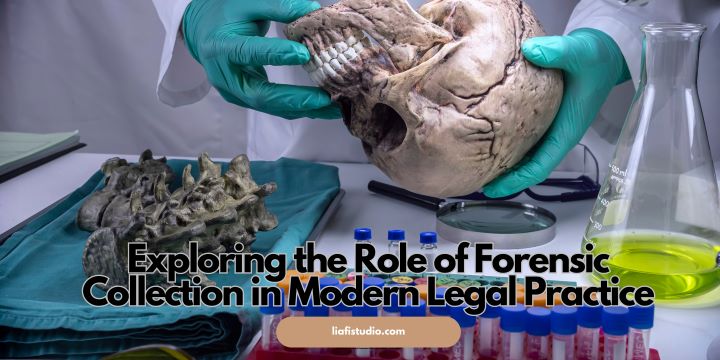Key Takeaways:
- Forensic collection is a critical and intricate component of modern legal practices, crucial in the analysis and litigation involving digital evidence.
- Data integrity is paramount in judicial procedures, and emerging technologies present innovative solutions and challenges.
- Forensic collection constantly expands and is influenced by evolving privacy laws and global legal structures.
Table of Contents:
- Understanding Forensic Collection in the Legal Landscape
- The Importance of Data Integrity in Forensic Collection
- Advanced Techniques in Forensic Data Recovery
- The Intersection of Privacy Laws and Forensic Collection
- Forensic Collection in Corporate Litigation
- Training and Expertise Required in Forensic Collection
- Ethical Considerations in Forensic Data Collection
- Challenges and Future Trends in Forensic Collection
- Forensic Collection and International Law
- Conclusion: The Critical Role Forensic Collection Plays in Legal Outcomes
Understanding Forensic Collection in the Legal Landscape
The meticulous world of forensic collection forms an integral pillar in the towering structure of the modern judicial process. While the layperson might conjure images of dusting for fingerprints and labeling physical evidence when they think of forensics, the digital age has ushered in a nuanced era of evidence management – one in which bytes and bits are as significant as DNA samples and fingerprints. Forensic collection specializes in the secure harvesting and analysis of this digital evidence, parsing through the immensity of electronic documentation to isolate and protect the data that could be pivotal in a court of law. Its relevance has surged due to the dependence on digital communication and storage, revolutionizing how evidence is collected and presented.
Unlike a paper trail that may degrade over time or is prone to mishandling, digital data-bearing devices demand expertise beyond preservation. They require an in-depth understanding of the technology involved and a grasp of the intricate laws that govern these cyber domains. Here, the standing of forensic collection soars high, ensuring that amidst the complexities of legal disputes, evidence is acquired with precision, safeguarded against tampering, and remains untainted from its source until it becomes a subject of scrutiny under the law. In considering the evolution of legal standards that frame forensic practices, one finds an intersection of technological changes, rigorous scrutiny, and an unwavering commitment to detail.
The Importance of Data Integrity in Forensic Collection
The sanctity of data, as it transitions from its native digital habitat through the evidentiary process to the courtroom, lies in its integrity. The legal lattice that upholds this integrity is the chain of custody. This documented lineage follows the evidence from its inception point through the myriad hands, digital tools, and analytic prisms it may pass before it finds a resting place in legal argumentation. Each touchpoint must be thoroughly documented to thwart data corruption—a digital document’s worst nemesis. Implementing a rigorously structured chain of custody mitigates risks associated with data manipulation and thus bolsters the probative value of the evidence. Professionals adept in forensic collection are often seen walking a tightrope, balancing the need for data extraction with the imperative of data preservation.
In the arena of forensic collection, each step is deliberate. Techniques must be bulletproof against authenticity challenges and agile enough to adapt to the diverse arrays of data retention environments—from the unyielding solidity of a damaged drive to the volatility of ephemeral cloud storage. The professionals’ mandate is clear: operate within a framework that holds up against scrutiny, even as that framework is compelled to evolve with the technologies and methodologies that define data storage and security today.
Advanced Techniques in Forensic Data Recovery
The art and science of forensic collection are well exemplified in the meticulous craft of data recovery. Whether dealing with intentional data concealment, accidental deletion, or damage to the data receptacle, modern recovery techniques have kept pace, reflecting the resilience of digital forensics amidst the challenges. Not confined to mere retrieval, these processes employ advanced tools that use algorithms, artificial intelligence, and predictive analytics to recover what’s been lost and anticipate what might be most relevant for legal scrutiny. This merger of technique and technology strikes at the heart of forensic efficiency, reducing the time needed to sift through copious amounts of information and refining the precision with which pertinent data is identified and extracted.
True-to-life examples are abundant where these advanced modalities of forensic collection have tilted the scales of justice. Intricate case studies become the legends that industry professionals relate to one another, which speak of nearly impossible odds overcome by the deft use of sophisticated technology. These success stories serve as instructional tales and testaments to the innovations that continue to shape the realm of legal digital forensics.
The Intersection of Privacy Laws and Forensic Collection
In tandem with the growing arsenal of forensic technologies is an ever-morphing landscape of privacy regulations. Legislative bodies around the globe have been tasking themselves with protecting personal data and producing laws such as the European Union’s GDPR. These laws cast a broad net, capturing within their scope the activities of beneficiaries and practitioners of forensic collection alike. They serve as both shield and hurdle, protecting the rights of individuals while presenting complex challenges that must be navigated with acuity. Thus, Collecting digital evidence becomes an exercise in legal gymnastics, where the ability to adapt and comply with these protections is as crucial as the forensic collection process.
This sensitive interface between data protection and evidence gathering is hardly a minor concern. Missteps can undermine the credibility of the collected evidence and, by extension, the cases that rely on them. The experts engaged in forensic collection need to remain aware of the potentially onerous consequences of infringing on privacy protections, making the equilibrium between obtaining evidentiary data and upholding privacy rights a centerpiece of ethical practice.
Forensic Collection in Corporate Litigation
With its particular predilection for amassing expansive data troves, the corporate sector finds a succinct ally in the forensic collection when legal battles ensue. Intellectual property disputes, allegations of trade secret theft, and corporate litigation hinge on evidence lodged within the enterprise’s digital fortress. Here, forensic collection is not a mere tool but a strategy—a means to unearth and structure evidence that can turn the tide of legal arguments, a pivotal factor that could steer the judgment in favor of the truth. The meticulous dissection of bytes, coupled with the intuitive understanding of corporate data governance, becomes an act of legal finesse, pulling back the curtain on hidden truths within terabytes of corporate workflow and communications.
The recounting of such instances isn’t rare—the legal annals are replete with cases where the adept harnessing of the forensic collection has elucidated facts otherwise obfuscated within the dense thicket of corporate data structures. Such triumphs underscore the indispensability of forensic collection in the quest for legal clarity and its role in fostering an environment where corporate misconduct and fraud find fewer shadows to lurk within.
Training and Expertise Required in Forensic Collection
The vocation of a forensic collection expert is a fusion of various disciplines—each demanding an exemplary level of competency and specialization. This profession calls for a strong foundation in both, cultivated through dedicated education and nurtured through continuous professional growth. Aspiring practitioners tread the path of certifications and training programs, acquiring the rights of passage that qualify them to engage with the exacting intricacies of forensic data. Ongoing education becomes a staple in their professional diets, feeding their expertise with the latest advancements and industry practices.
In the choreography of modern litigation, legal professionals and IT experts dance in tandem, each bringing their finesse to the legal stage. This collaboration, a melange of acumen and technical prowess, harmonizes the demanding requirements of digital forensics with the nuanced understanding of legal statutes and procedures. The result is a confluence of insights and skills that elevate the quality and efficacy of forensic work in the digiscape of law.
Ethical Considerations in Forensic Data Collection
The high-stakes nature of legal conflicts demands that all methods implemented, including forensic collection, adhere to ethical frameworks affirming the legal process’s integrity. The professionals in this domain not only carry the weight of technical responsibilities but also bear the flag of moral standards. They operate in an environment where boundaries are defined by legal precedence and professional covenants, and the consequences of straying into the territory of unethical practices can significantly compromise both individual and collective reputations, not to mention the legal outcomes they aim to influence.
For the custodians of digital truth—the forensic collection specialists—these ethical considerations form a bulwark against practices that threaten the very principles of jurisprudence. Compliance with these ethical mandates ensures that the truth emerges unblemished by misconduct and that the scales of justice weigh evidence untainted by malfeasance. Recognizing the complexities involved, the American Bar Association advises legal professionals to embrace a proficient command of electronic evidence. The guidelines prompt lawyers to engage with forensic technologies actively, ensuring compliance with legal standards and fostering a meticulous approach to digital evidence management.
Challenges and Future Trends in Forensic Collection
Digital currents are ever-shifting, bringing forth waves of new devices, applications, and means of communication. The forensic collection surfs these waves, staying ahead of the technology curve to efficiently extract and preserve evidence from newer, often more complex sources. The invasion of the Internet of Things (IoT) into every conceivable sphere, the ascent of cloud computing, and the proliferation of encryption pose fresh trials for forensic professionals. To confront these challenges, they armor themselves with knowledge and tools that offer mastery over these novel landscapes of digital evidence.
Looking forward, one can anticipate a landscape where forensic collection practitioners’ adaptability and continuous learning will shape their ability to traverse the ever-evolving terrain of digital data. These future trends are not mere speculation but guideposts that signal the transformative journey the discipline is on—a journey that will see forensic collection redefine its place within the overarching narrative of legal praxis.
Forensic Collection and International Law
A world without borders rings especially true in the context of digital data, as corporations carry out operations that transcend geographical limits with ease. This digital expanse creates a tapestry of international law that forensic collections must seamlessly weave through. It is a jigsaw of jurisdictions, each with its piece in the shape of unique legal systems and privacy legislation. The challenge, and indeed the skill, is to gather and preserve digital evidence that appeases the regulations of multiple sovereignties and stands robust through the scrutiny of disparate legal systems. It is a task demanding of its practitioners not merely understanding laws and technical proficiency but also diplomatic finesse.
Using best practices derived from cross-border forensic collection experiences reveals ways to align these divergent legal expectations. These cumulative experiences, forged in the complex interdependences of international law and digital evidence, form the bedrock of effective practice in the global arena of forensic data.
Conclusion: The Critical Role Forensic Collection Plays in Legal Outcomes
In summation, the role of forensic collection in the contemporary landscape of law is cardinal and inextricable. Legal professionals vested in pursuing digital evidence wield it as a vital instrument that discerns the relevant from the redundant and the authentic from the impure. As the realms of data and law continue to blend and evolve, the practice of forensic collection stands at the forefront, a beacon guiding the trek through the legal intricacies of our digitized world. It balances the scales of legal discourse, ensuring that justice, supported by the robust pillars of forensic evidence, is served with fairness and accuracy.








